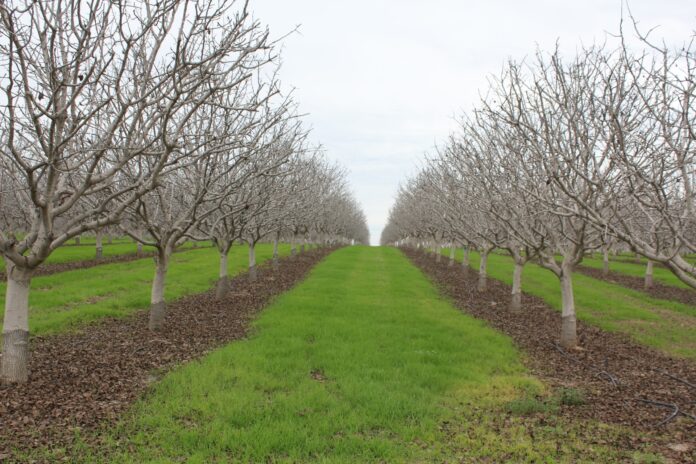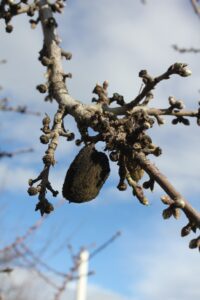
Invasion of pest species that impact crop production, crop quality and even tree growth are trials that every pistachio grower faces. While endeavoring to harvest a marketable crop every year, growers are finding fewer chemical tools available to them for pest control. Compounding the problem is a changing climate that appears to favor increased pest reproduction.
Indication of this increase was noted by UC orchard systems advisor Katherine Jarvis-Shean in her presentation at the 2024 UC Statewide Pistachio Day. The pest that poses the biggest potential threat to pistachio crop quality, navel orangeworm (NOW), is expected to be able to produce more generations every year. Warmer temperatures earlier in the spring mean earlier NOW flights resulting in more generations by the fall. Increased NOW numbers when nuts are vulnerable, mean a loss of marketable nuts and a hit to grower checks.
Besides NOW, leaffooted bugs, stink bugs, Gills mealybug, the invasive Carpophulis beetle and even nematodes all pose threats to profitable pistachio production.
Houston Wilson, UC Riverside entomology specialist based at the Kearney Ag Center, said progress has been made in identifying a pheromone lure for leaffooted bugs. With an effective lure and trap, he said growers and managers will be able to see trends in orchard populations and determine if control measures are warranted.
In pistachio production, LFB feeding early in the season can cause epicarp lesion, nut drop, and create conditions conducive to pathogens. Later feeding, after shell hardening can cause kernel necrosis. This pest is also known to transmit stigmatoycosis, Botryosphaeria and shoot blight. Without an established economic threshold, growers and crop managers have relied on direct sampling (i.e. visual assessments and beat sampling) to find adults or feeding lesions. The development of a lure and trap give them a more accurate prediction of crop damage from this pest, plus save a lot of time on sampling efforts.

Identification and synthesis of all 9 components of the LFB pheromone has been achieved and trap design has been improved to enhance monitoring ability. Wilson said this year’s plan is to continue evaluating and refining lures, as well as work with pheromone companies to determine if an affordable lure can be produced at scale.
Mealybug Intercepts Carbohydrates
Gill’s mealybug continues to infest pistachio orchards. UCCE entomology and pest management farm advisor David Haviland said this pest intercept carbohydrates intended to for nut development, the feeding results in smaller size nuts and less shell split.
Crawlers are targeted for insecticide treatments because they are easier to kill.
“Back in the day there was one treatment and it was done,” Haviland said. More recently, pistachio growers and crop managers have found that the usual insecticide treatments are not as effective. Haviland’s trial looked at effects of insecticide applications on mealybug densities from late March to harvest. Haviland said the most significant result of the trial was that Movento was not effective in any of the six treatments where it was included. It previously was determined to be the most effective.
The industry standard products, Assail was effective as a solo treatment or in combination with other products applied in late May or late July. Haviland’s other significant finding was evidence that late March is viable application timing for Centaur. This is important, Haviland noted, because it is an effective product, but it cannot be used in late May due to residue tolerance levels for marketing in the EU.
Haviland noted that if mealybug signs are found in an orchard post harvest, not to waste money on an insecticide application then, but note the location and treat in the spring.
A graph showing efficacy of insecticides can be found in the 2023 Research of the California Pistachio Research Board.
Nematode Warning
For 40 years, pistachio growers have not worried about nematodes affecting tree growth, but things have changed according to UC Riverside nematologist Andreas Westphal.
In a presentation at the UC Statewide Pistachio Day, Westphal said the increase in pistachio acres planted after walnut orchards were removed, plus the difference in rootstock genetics compared to 40 years ago suggest caution. Walnuts are a notorious host for P. vulnus, commonly known as root lesion nematode. Population densities of this soil pest take longer to develop in pistachios, with trunk diameter being an indicator of presence of high levels of root lesion nematode in the soil.
Westphal said field screening showed low population densities root knot nematode and root lesion nematode in pistachio compared to other nut crops hosts, but numbers have increased since 2017 including in 2018 planting of UCB1 genotypes at the end of 2022. After 5 years of planting and inoculation, root lesion nematode numbers in several of the UCB1 clones were similar to the susceptible nut crops on peach rootstock Nemaguard and the walnut rootstock VX211.
More information is needed to corroborate the damage potential of root lesion nematode, Westphal said, but caution – and soil samples are advised when planting pistachio after walnut. Mitigation should be considered, he added, depending on detected population densities in the orchard site.
Carpophilus Beetle on the Rise
The latest insect pest to threaten tree nut crops is the Carpophilus beetle (Carpophilus truncatus), the only species of Carpophilus known to attack tree nuts. It has gained a reputation in Australia for damaging almonds over the past 10 years. Australian knowledge and experience with this pest will be helpful to U.S. growers, Wilson said, and he is already in contact with his counterparts in Australia to learn more and build collaborations. This beetle was first found in California tree nut orchards in September 2023, and subsequent reports of this pest have been confirmed from Kings, Madera, Merced and Stanislaus counties. Samples were sent to the CDFA lab and identity was confirmed.
Now, Wilson said, plans are to collaborate with Australia and conduct dual season trials. There are still a lot of unknowns about this pest, Wilson said. One key feature is that they overwintering in remnant mummy nuts, so like NOW, crop sanitation is critical for management of Carpophilus beetle.
Successful chemical or biological controls for Carpophilus beetles have yet to be identified. Chemical controls to date have produced highly variable results, primarily due to difficulties with coverage. Orchard sanitation is strongly suggested as this beetle overwinters in mummy nuts much like navel orangeworm. Wilson said this pest is well known by Australian almond growers, whose primary management tool is winter sanitation.
Carpophilus beetle adults will move to new crop nuts around hull-split. They can chew thorugh the almond shell and then deposit eggs directly onto the kernel. The larvae will then tunnel into almond kernels, where their feeding leaves behind a fine white powdery substance, likely a mix of nutmeat and frass. Infestations have been documented in pistachio as well.
Wilson and his colleagues Jhalendra Rijal (UC IPM Advisor – North San Joaquin Valley), David Haviland (Entomology Far Advisor, Kern Co.) and Sudan Gyawaly (UC IPM Advisor – Sacramento Valley) hope to learn more about the ecology and management of this pest in their trials over the 2024 season. Meanwhile, Wilson strongly emphasized the importance of orchard sanitation to control this pest. Chemical control has not proven effective due to challenges with coverage and there is no known bio control at this time.










